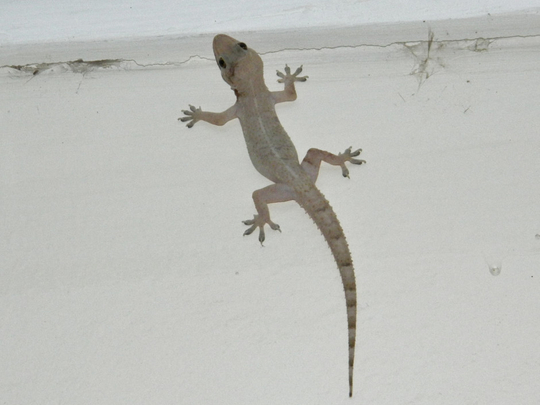
You just utter “lizard”. And the next moment I find that it is enough to make my daughter scurrying for cover shrieking chhipkali (Hindi word for the home-grown reptile).
She would grab me by my clothes pleading to get rid of what she would say “that ugly lizard” from the walls of our rooms. “No, no, I cannot put up with that nasty thing. Please do something about the problem”, she would implore stomping her shoes like a kindergarten girl.
And that persistent demand makes me wonder about how to get over this lizard menace which is an annual phenomenon. There are many of them that swarm the walls hiding behind hanging pictures, photo frames and what not.
Towards the end of May/June, tiny lizards of one-and-a-half to two inches in size would crawl all over the place. Their appearance indicates that the rains are around the corner. The wet weather gives birth to kilos of insects, winged and otherwise, who make a good meal for these creatures.
We may detest this mud-coloured lizard but nature has created them to consume those flying and other insects — a sort of scavenging process. When tiny, they are not that scary as they are when they grow into full-fledged five to six-inch lizards.
I remember a Japanese lady shrieking and rushing out of her room in a hotel in Delhi gasping for breath and pointing towards a lizard on the wall. She later quit the hotel moving to a ‘safer’ place. I don’t know whether she had another odyssey with the creepy crawly.
Pest control experts claim that they can totally eliminate them but practical experience disproves the claim. Initially these lizards, or for that matter, cockroaches and other insects do disappear following pest control treatment, though it poses a big health hazard to the inmates of the house and to the stored food items. But with the effect of the insecticide waning, they appear again. Seemingly there is no permanent way to get rid of them.
Appearance of lizards is a normal feature in all the places in tropical India. Over the years, we have learnt to co-exist with them. I have been watching winged and crawly creatures, moths, flying ants and other insects appearing from nowhere soon after a spell of rains, mainly below tube lights and electric bulbs. And with them come lizards roaming about with mouthful of insects digesting them all so quickly and then going on for more servings.
The hard fact is that I have lived with them right from my childhood. We were never bothered about their presence. They appeared, had their food and then hid inside their hideouts. They did not disturb or harm us in any way and we did not bother them. That is how we lived under the same roof.
No sealing them out
Rarely did we hear a lizard having fallen in a vessel containing something edible, left open by a careless housewife that might poison the food. Otherwise, both sides have respected each other’s domain.
It was just impossible to seal the doors to prevent lizards coming inside the rooms. This is just well-nigh impossible. They manage to somehow creep in even through the narrowest crevices. These reptiles do not know boundaries. You cleanse your premises of them but they would sneak in from your neighbour’s house. So for an ordinary Indian, there is no riddance from a necessary evil called the lizard.
I have been telling my daughter to learn to co-exist with them as they would continue to appear during the monsoon season to devour insects but she refuses to even look at them. Having spent a pretty long time abroad in lizard-free conditions, she just can’t stand them.
We need to live with them. There is no option. Just as we learn to live with moths, flying ants and insects, and other seasonal pests that keep hovering around electric lights.
This is not a eulogy for the domestic lizard. It is an expression of helplessness against a necessary evil.
Lalit Raizada is a journalist based in India.











